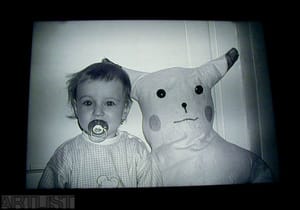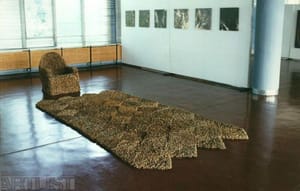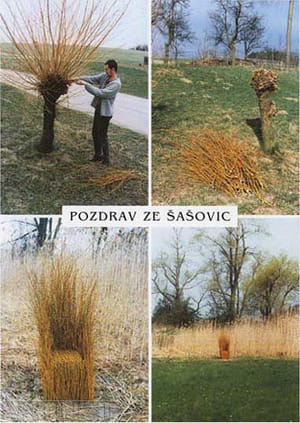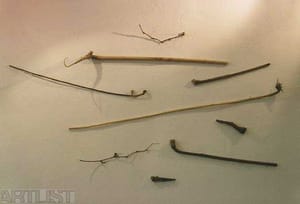- First Name
- Pavel
- Surname
- Ryška
- Born
- 1974
- Birth place
- Třebíč
- Place of work
- Prague
- CSU Library
- ↳ Find in the catalogue
About artist
Belongs to the Brno circle of artists, even if he originally hails from Třebíč, where in the mid-1990s, just prior to his studies at the School of Creative Arts (FaVU), he created his first works. It was a series of armchairs in the open landscape; for example, the Whitewashed Aluminium Chair / Hliněné křeslo obílené vápnem (1994). The whitewash dissolved in the autumn rain. Or he also made the Woven Willow Chair / Křeslo z vrbového proutí (1996). This one took root in the wetlands just beyond the village of Šašovice, where the artist lived at the time. Ryška’s early works are typified by a mystical intervention in the surrounding environment joined with events and by their metamorphosis as part of a precise concept. In 1997 he paraphrased „life-saving“ activities, when as part of the Weeds /Plevel project he marked dozens of Cow Parsnip plants with grandiose tags featuring the text „Plants Hunted by the State.“ Thereafter he manufactured, based on the standard model for seed bags used by the company, SEMO, further sacks for the aggressive weed variety, Cow Parsnip. He smuggled these bags of seed into garden supply stores. In his subsequent project Easter Eggs (Happy Easter)/Kraslice (Veselé velikonoce)- (1996) he comically touched upon a sensitive social topic. He transformed poppy heads in that on each one, using industrial latex, he drew fake traces of running, raw opium juice. In further projects in nature, such as Deer-stand – Public Library / Posed – Veřejná knihovna (1997), he used a number of dear-stands around the village of Šašovice to change the area into a comfortable reading room. These were a suggestive probe into real life and the world of art.
At the end of the 1990s Ryška began to work with computers. Digitally-manipulated images began to emerge along with installations like GOTTA CATCH ‘EM All (2002) or Death Valley (2003). This shift from events and interventions into his surroundings to computer comic visuals gives the impression of a fundamental watershed in Ryška’s creative works. The artist begins to create virtual, often animated, stories, which continue however to maintain a conceptual approach typical for Ryška, subversive humour. This appears as well in his next series, Thoughts of Modern Painters / Myšlenky moderních malířů (2004). In this cycle he addresses the history of modernism in a novel way so that he could parody fundamental artistic works of the 20th century. His short, animated film, Ursonáta (2004) plays a little with the legacy of Dadaism. Despite their limited conceptualism and wild post-modern mix of high and low (art), even these Ryška works have their own irreplaceable poetic visuality.
- Author of the annotation
- Pavlína Morganová
- Published
- 2005
CV
Studies:
1998-2004 Faculty of Fine Arts, Brno University of Technology, Brno
(Peter Rónai, Petr Kvíčala)
Stipends:
2005 doktorský studijní program FAMU (Centrum audiovizuálních studií), Praha
2001 Magyar Iparmüveszeti Föiskola, Budapešť, Maďarsko (ateliér grafického designu)
Exhibitions
- Solo exhibitions
-
2006
Pavel Ryška, Galerie Eskort, Brno
www.ryska.org, Krajská galerie výtvarného umění ve Zlíně, p. o., Zlín
2005
Pavel Ryška: Prasonáta budoucnosti, etc. galerie, Praha 4
2004
Záhada čínského pokoje. Moravská galerie Brno, Pražákův palác
2002
Gotta catch ´em all. Galerie Jelení Praha
- Group exhibitions not included in ARTLIST.
-
2012
Začátek století / The Beginning of the Century, Dům umění, Ostrava
Začátek století / The Beginning of the Century, Výstavní síň Masné krámy, Plzeň
2008
Dočasný důkaz, Výstaviště Flora, pavilon E, Olomouc
2007
Cooking Art aneb Smažíme umění, Galerie kritiků, Praha
Amaro Jilo / Naše srdce, Dům umění města Brna, Brno
2006
FRISBEE - Současný český videoart a nová média / Contemporary Czech Videoart and New Media, Výstavní síň Sokolská 26, Ostrava
Jan Nálevka & Pavel Ryška: Kontrolovaná emigrace, Galerie 36, Olomouc
Shadows of Humor: Przykra sprawa CzeSka wystawa, Galeria Awangarda, Wrocław
FRISBEE - Současný český videoart a nová média / Contemporary Czech Videoart and New Media, Dům pánů z Kunštátu, 1. patro, Brno
2005
Fotografie ze sb. dr. Rudolfa Weisse, Ateliér Josefa Sudka, Praha
Druhý dotek, Dům pánů z Kunštátu, 1. patro, Brno
Insiders: Nenápadná generace druhé poloviny 90. let / The Unobtrusive Generation of the Late 1990s, Centrum pro současné umění FUTURA, Praha 5
2004
Start Point Prize CZ 2004, Sýpka Klenová, Klenová
2003
Nejmladší / The youngest: Přehlídka výtvarného umění nejmladší generace z let 1995 - 2003 (Exhibition of the youngest Generation Art from 1995 - 2003), Veletržní palác, Praha
2000
Sýpka 2000. Posluchači vysokých uměleckých škol, Galerie Sýpka-Vlkov, Osová Bítýška
1999
A.D.S. Brno, Galerie Doubner, Praha
Animal Art či ZOO-Kunst - Práce pro místo, Galerie Sýpka-Vlkov, Osová Bítýška
- Collections
-
KGVU Zlín
Národní Galerie v Praze
Galerie Klatovy - Klenová
Monography
- Articles
2005
Jiří Ptáček: Fotografie ze sbírky Dr. Weisse
2003
Jiří Ptáček: Hvězda a brána šedého hradu: Velký Participant, Umělec 2/2003
2004
Horké místo a osud na okraji. Mezinárodní projekt v Brně, Art & Antiques, 4/2004
Tomáš Pospiszyl: Prasonáta budoucnosti, Záhada čínského pokoje (katalog), Mor. Galerie Brno
Marek Pokorný: Vrakoviště, Je slovní fotbal na všechny slabiky karaoke? (katalog)
Jiří Ptáček: Čínský čaj si dáváme o páté, Záhada čínského pokoje (katalog), MG Brno
Pavlína Morganová: Insiders (katalog), Dům umění Brno
Klára Kubíčková: Houbaři do galerie nechodí, interview P.R., Praesens 4/2004
Petr Ingerle: Záhada čínského pokoje
Jiří Maška: Záhada čínského pokoje
2002
Jiří Ptáček: Prolhaný Pokémon, Ateliér 6/2002
2000
František Kowolowski: Pavel Ryška, II. ZSM (katalog), Zlín
1999
Pavlína Morganová: Akční umění, Votobia, Olomouc









